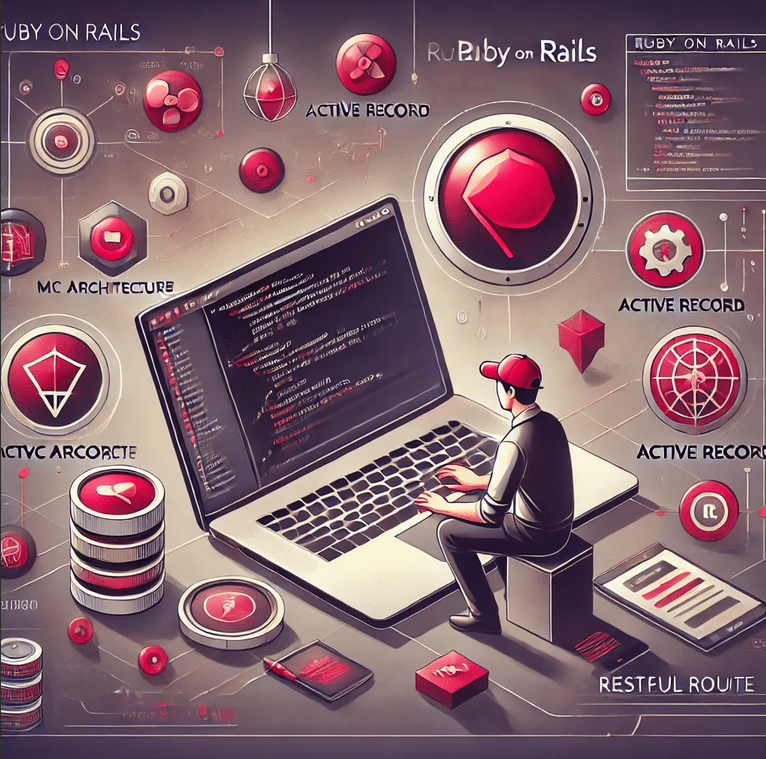In the ever-evolving landscape of web development, efficiency and simplicity are paramount. Developers seek tools that not only streamline their workflow but also enhance their productivity and ensure robust performance. Ruby on Rails, often simply referred to as Rails, is one such tool that has garnered widespread acclaim for its developer-friendly features and powerful capabilities. This article delves into the essence of Ruby on Rails, its key features, and how Curate Consulting Services can assist enterprises in finding specialized talent to leverage Rails for their web development needs.
The Essence of Ruby on Rails
Ruby on Rails is a web application framework written in the Ruby programming language. It follows the model-view-controller (MVC) architectural pattern, which separates an application into three main components:
- Model: Represents the data and business logic.
- View: Handles the presentation and user interface.
- Controller: Manages the communication between the model and view.
This separation ensures a clean and organized codebase, making it easier for developers to manage and scale their applications.
Convention over Configuration (CoC)
One of the standout principles of Ruby on Rails is Convention over Configuration (CoC). This principle minimizes the need for explicit configuration by relying on sensible defaults and naming conventions. By reducing the amount of configuration code, Rails allows developers to focus on building features and functionality rather than getting bogged down in setup details.
Don’t Repeat Yourself (DRY) Principle
Another core tenet of Rails is the Don’t Repeat Yourself (DRY) principle. This principle encourages developers to write reusable code and avoid duplicating logic. Rails achieves this through features such as helpers, partials, and other reusable components, ensuring that code remains concise and maintainable.
Active Record ORM
Rails includes the Active Record Object-Relational Mapping (ORM) framework, which simplifies database interactions. Developers can work with databases using Ruby objects, and Rails automatically handles the translation between these objects and the underlying database tables. This abstraction layer streamlines database operations and reduces the complexity of database management.
Scaffolding
Rails provides a scaffolding feature that generates code for basic CRUD (Create, Read, Update, Delete) operations. This allows developers to quickly create prototype applications and then customize the generated code as needed. Scaffolding accelerates the development process, enabling rapid iteration and feedback.
Gem System
Ruby on Rails leverages RubyGems, a package manager for Ruby libraries and applications. The Gem system allows developers to easily integrate third-party libraries, extend functionality, and share code with the community. This vast ecosystem of gems enhances the capabilities of Rails and promotes code reuse.
Active Support
Rails includes a library called Active Support, which provides utility classes and extensions to the Ruby core classes. Active Support adds functionality such as string manipulation, date and time formatting, and more, enriching the Ruby language and making it even more versatile for web development.
RESTful Routes
Rails promotes the use of RESTful routes, making it easier to design clean and consistent APIs. RESTful conventions map HTTP verbs (GET, POST, PUT, DELETE) to controller actions, simplifying the creation of RESTful web services. This approach ensures that APIs are intuitive and align with standard web practices.
Asset Pipeline
The asset pipeline in Rails manages and organizes assets such as stylesheets, JavaScript files, and images. It includes features like minification, concatenation, and fingerprinting for cache-busting. These capabilities ensure that assets are efficiently delivered to clients, enhancing the performance of web applications.
Convention-Driven Testing
Rails encourages testing through its built-in testing framework. Developers can write unit tests, functional tests, and integration tests to ensure the reliability and correctness of their applications. This emphasis on testing fosters a culture of quality and robustness in the development process.
Community and Ecosystem
Ruby on Rails boasts a vibrant and active community. This community-driven nature results in a wealth of plugins, gems, and resources available for developers. The collaborative spirit of the Rails community ensures that developers have access to the latest tools and best practices, continuously evolving the framework.
Scalability and Performance
While Rails is known for its developer-friendly features, it also provides tools and best practices for scaling applications. Techniques such as caching, database optimization, and background processing contribute to improving performance. Rails’ scalability ensures that it can handle the demands of both small startups and large-scale enterprises.
Real-World Applications of Ruby on Rails
Ruby on Rails has been widely adopted for building a variety of web applications, from small startups to large-scale enterprises. Its emphasis on developer productivity, elegant syntax, and strong community support have made it a popular choice in the web development world.
Use Case: Startups
For startups, the ability to quickly iterate and pivot is crucial. Ruby on Rails’ scaffolding, convention over configuration, and DRY principles enable rapid development and prototyping. Startups can bring their ideas to market faster, gather user feedback, and make necessary adjustments without extensive redevelopment efforts.
Use Case: E-commerce Platforms
E-commerce platforms require robust and scalable solutions to handle high traffic and secure transactions. Rails’ RESTful routes, asset pipeline, and Active Record ORM provide a solid foundation for building secure and efficient e-commerce applications. Features like caching and background processing further enhance performance, ensuring a seamless shopping experience for users.
Use Case: Social Networking Sites
Social networking sites demand features such as real-time updates, user interactions, and media handling. Rails’ convention-driven testing and active support libraries streamline the development of these features. The gem ecosystem offers ready-made solutions for common social networking functionalities, allowing developers to focus on creating unique user experiences.
Use Case: Content Management Systems (CMS)
Content management systems benefit from Rails’ MVC architecture and scaffolding. Developers can create customizable and user-friendly CMS solutions that allow non-technical users to manage content efficiently. Rails’ emphasis on reusable code and modular design ensures that CMS applications are maintainable and scalable.
Curate Consulting Services: Your Partner in Leveraging Ruby on Rails
At Curate Consulting Services, we recognize the transformative potential of Ruby on Rails for web development. Our team of experts is dedicated to helping organizations harness the full power of Rails to build innovative and efficient web applications.
Finding Specialized Talent
One of the biggest challenges enterprises face is finding specialized talent to implement and manage Ruby on Rails applications. At Curate Consulting Services, we have a proven track record of identifying and recruiting top-tier Ruby on Rails developers. Our rigorous screening process ensures that we provide our clients with the best talent available, capable of addressing their unique development needs.
Tailored Solutions
We understand that every organization has distinct requirements. Our consultants work closely with clients to understand their specific needs and develop tailored solutions that align with their goals. Whether you need help with building a new application, optimizing an existing one, or scaling your infrastructure, our team is equipped to deliver results.
Continuous Support
Web development is an ongoing process. Our relationship with clients doesn’t end once the initial implementation is complete. We provide continuous support to ensure that your Rails applications remain performant and up-to-date. This includes regular code reviews, performance assessments, and updates to leverage the latest Rails features and best practices.
Training and Development
In addition to providing specialized talent, we offer training and development programs to help your in-house team master Ruby on Rails. Our training sessions are designed to equip your developers with the skills and knowledge they need to build and maintain high-quality Rails applications. By investing in your team’s growth, we help you build a sustainable and self-sufficient development ecosystem.
Conclusion
Ruby on Rails stands out as a powerful and efficient framework for web development. Its emphasis on convention over configuration, the DRY principle, and a strong community support system make it an excellent choice for building scalable and maintainable web applications. At Curate Consulting Services, we are committed to helping organizations unlock the full potential of Ruby on Rails. By providing specialized talent, tailored solutions, and continuous support, we ensure that your web development projects are successful and sustainable.
Whether you’re a startup looking to bring your idea to market quickly, an enterprise seeking to optimize your e-commerce platform, or a company aiming to build a robust social networking site, Ruby on Rails offers the tools and flexibility you need. Contact Curate Consulting Services today to learn how we can help you achieve your web development goals with Ruby on Rails.



